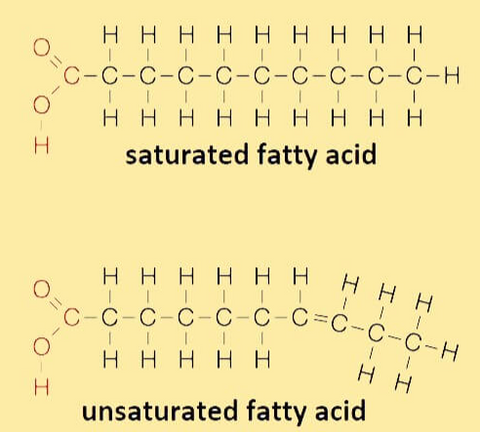(Psst…none of this is medical advice–just a word to the wise.)
You’ve probably heard that polyunsaturated fats are out and saturated fats are in.
But it’s not that simple. And health should never feel like a fashion trend. Right?
While it’s true that the fat in your food and skincare matters, it’s more nuanced than “good” or “bad.”
In this post, we’ll explore the why behind the seed oil hate and what it means for your health.
Our goal is always to skip the trends and follow the facts. So let’s dig in.
What are polyunsaturated fats exactly?
Here’s some background without getting too technical (hopefully).
It’s all about structure and stability.
All fatty acid chains are bonded with three elements: oxygen, carbon, and hydrogen. “Saturation” just means that each carbon molecule is fully covered by all the hydrogens possible.
“Unsaturation” implies that some hydrogen atoms have been removed– making an extra carbon bond necessary.

Polyunsaturated fats have more than one unsaturated carbon bond. This is relevant because more bonds mean more chemical changes are possible– ergo, instability.
One of these reactions is known as oxidative rancidity. This is the main issue with polyunsaturated fats. (1)
Since they exist in organisms found in lower temperatures, they must be liquid when cold. This means that when PUFAs are exposed to air or heat, they begin to break down. Even cold-pressed unsaturated oils oxidize in our warm, 98F, oxygen-rich bodies. (2)
Oxidation occurs when a substance loses one or more electrons in a reaction. (3) Picture that rusty old bike you left outside when you were little. Or the browning apple on the counter you forgot to finish. Not a pretty sight.
Saturated fats, on the other hand, are much less likely to oxidize in these conditions because their structure is more stable. Think warm-blooded animals and tropical plants.
Still with us?
Great– now let’s look at how this reaction might harm your health.
Why are PUFAs bad for you?
Ever heard of free radicals? These imbalanced molecules are byproducts of normal cellular respiration. And the body is really good at neutralizing them with antioxidants. No harm done– usually.
They can become problematic when there are too many of them– which happens when the body is stressed out or exposed to toxins (two things that are inescapable in our modern world).
An overload of free radicals harms healthy cells and can lead to metabolic damage, immunodeficiency, and accelerated aging.
This is precisely what happens when PUFAs oxidize in the body or on the skin– it’s stressful.
Free radical damage can show up as
- Fine lines and wrinkles
- Liver and age spots (especially in the presence of iron– a story for a different blog post)
- Inflammation inside and out
- Digestive issues
- Increased adipose tissue (body fat)
- Respiratory distress
- Coronary problems
When something negatively impacts the cell, it affects everything. (4)
Unfortunately, many foods and skincare products, both mainstream and natural, contain high amounts of PUFA-rich oils. And they’re often rancid way before hitting your plate or your skin.
You may be wondering why seed oils have been so promoted by our governments and health officials if they’re so bad for us?
It probably comes down to their bottom line– these products are cheaper to make.
We don’t share this to scare you, but rather to arm you with the truth.
In order to take your health into your own hands, you must be willing to question the narratives, read the studies, and seek the answers.
That being said, what’s what?
Which fats are polyunsaturated? Monounsaturated? Saturated?
Every fat contains each of these fatty acid types– just in different ratios.
This means it's impossible to avoid polyunsaturated fats altogether. However, you can opt for foods that contain more stable, saturated fatty acids to lessen oxidative stress on the body.
Below is the fatty acid profile of oils commonly found in grocery store aisles and drugstore shelves. *these numbers are averages*
Fats that are less saturated:
“Polyunsaturated” (least stable):
- Soybean oil– 58% polyunsaturated, 30% monounsaturated fat, 12% saturated
- Canola oil– 32% polyunsaturated, 62% monounsaturated, 6% saturated ~ high amounts of unstable unsaturated fatty acids
- Corn oil– 59% polyunsaturated, 24% monounsaturated, 13% saturated
- Grapeseed oil– 70% polyunsaturated, 17% monounsaturated, 13% saturated
- Cottonseed oil– 55% polyunsaturated, 18% monounsaturated, 27% saturated
- Sunflower oil– 85% unsaturated, 15% saturated
“Monounsaturated” (slightly more stable):
- Olive oil– 73% monounsaturated, 11% polyunsaturated, 14% saturated
- Avocado oil– 70% monounsaturated, 14 % polyunsaturated, 16% saturated
- Almond oil– 70% monounsaturated, 20% polyunsaturated, 10% saturated
Fats that are more saturated (and most stable):
- Butter– 63% saturated, 26% monounsaturated, 4% polyunsaturated
- Ghee– 60% saturated, 40% unsaturated
- Tallow– 50% saturated, 42% monosaturated, 2% polyunsaturated (grassfed tallow typically has 45 percent less total PUFA than grainfed) (5)
- Suet tallow– 70-80% saturated, 9-19% monounsaturated, 1% polyunsaturated
- Coconut oil– 83% saturated, 6% monounsaturated, 1% polyunsaturated
- Raw Cream– 62% saturated, 38% unsaturated
***Wondering why jojoba seed oil isn't on the list? Well, it's actually classified as a wax "making it especially resistant to degradation, and it also possesses a high oxidative stability." So we love using it in the majority of our products.(7)
A good rule of thumb is that the more solid a fat is at room temperature, the more saturated it is.
But if you want to see the numbers for yourself, check out this easy-to-use fatty acid profile tool we found. Enter the oil in question, and an accurate fat composition will pop up in seconds. The more you know.
Does this mean nuts and seeds are evil? Not always. Several unsaturated fats have lots of beneficial nutrients, and eating them in their whole form slows the risk of rancidity because of the naturally occurring antioxidant vitamin E. (2) As the anthem goes: nature doesn’t make mistakes.
So a handful of your favorite nuts once in a while isn’t a sin, especially in the context of a nutrient-dense diet full of minimally-processed animal products and nourishing saturated fats. Find what feels right for you and your body.
Why is saturated fat good for skin?
Saturated fatty acids are protective and stabilizing.
They’re often referred to as “tropical fats” because they’re formed in warmer organisms and are more resilient at high temperatures. They can even reverse the damage caused by PUFA oxidation. (6)
Ever notice how you can leave a stick of butter out for weeks with no issues? Or how that jar of coconut oil lasts forever?
Saturated fats also make up at least 50 percent of our cell membranes, so our skin recognizes them right away.
These nourishing fats will
- Moisturize dry skin
- Lower inflammation
- Strengthen skin barrier
- Slow premature aging
- Hydrate the cells
This is why grassfed tallow is the bedrock of our brand and the base of every Fatskn product.
Your skin deserves to be nourished, protected, and resilient to stress.
As always, while we hope to be a no-nonsense resource, we encourage you to do your own research to find the healthiest options for you and your family.
You can check out our collection of good-for-you, tallow-based skincare products by clicking the link below. We hope to see you there!
References:
- Awada M, Soulage CO, Meynier A, Debard C, Plaisancié P, Benoit B, Picard G, Loizon E, Chauvin MA, Estienne M, Peretti N, Guichardant M, Lagarde M, Genot C, Michalski MC. Dietary oxidized n-3 PUFA induce oxidative stress and inflammation: role of intestinal absorption of 4-HHE and reactivity in intestinal cells. J Lipid Res. 2012 Oct;53(10):2069-2080. doi: 10.1194/jlr.M026179. Epub 2012 Aug 3. PMID: 22865918; PMCID: PMC3435540. https://www.ncbi.nlm.nih.gov/pmc/articles/PMC3435540/#:~:text=Dietary%20LC%20n%2D3%20PUFA,may%20decrease%20their%20nutritional%20value.
- Peat, R. (n.d.). Unsaturated Vegetable Oils: Toxic. Raypeat.com. Retrieved March 10, 2023, from https://raypeat.com/articles/articles/unsaturated-oils.shtml
- Gabi. (2021, July 12). Understanding Redox Reactions & Oxidation Reduction. ChemTalk. https://chemistrytalk.org/redox-reactions/#:~:text=Oxidation%20happens%20when%20an%20atom
- Cate, D. (2020, September 3). PUFA-Project: Scientific References on Seed Oil Toxicity. Dr. Cate. https://drcate.com/pufa-project/
- Fatty Acid Analysis of Grass-fed and Grain-fed Beef Tallow. (n.d.). The Weston A. Price Foundation. Retrieved March 10, 2023, from https://www.westonaprice.org/health-topics/know-your-fats/fatty-acid-analysis-of-grass-fed-and-grain-fed-beef-tallow/#gsc.tab=0
- Peat, R. (n.d.-a). Fats and degeneration. Raypeat.com. Retrieved March 10, 2023, from https://raypeat.com/articles/articles/fats-degeneration3.shtml
- Vaughn, Alexandra R.; Clark, Ashley K.; Sivamani, Raja K.; Shi, Vivian Y. (2017). Natural Oils for Skin-Barrier Repair: Ancient Compounds Now Backed by Modern Science. American Journal of Clinical Dermatology, PMID: 28707186.


